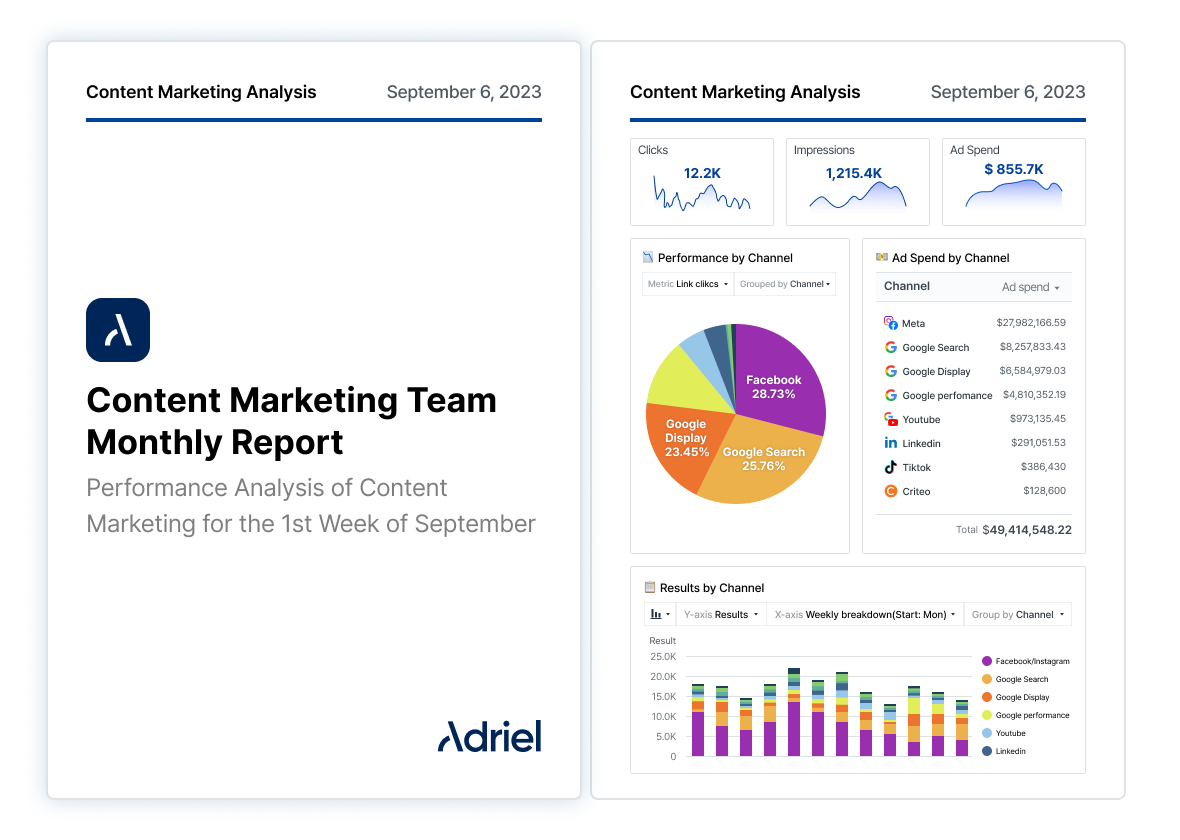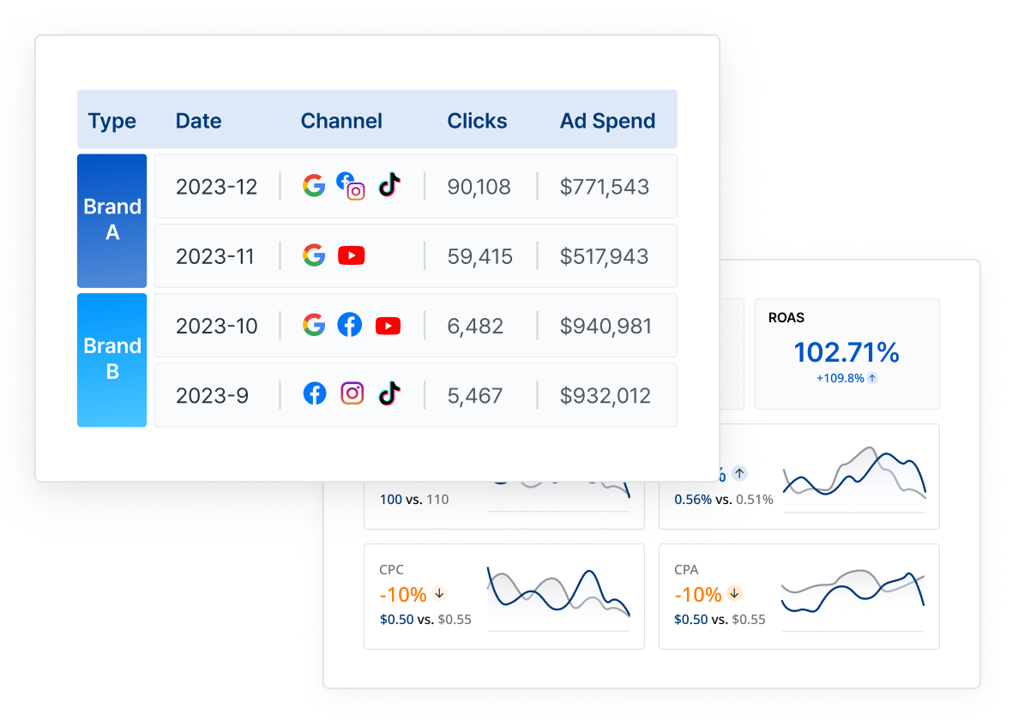Refer a partner and get paid! Earn 20% of all qualifying subscriptions referred to our team 👉

Learn More
Reporting digital marketing performance to C-Suite? No problem. Visualize a snapshot of marketing performance and key metrics on one dashboard. Download stunning white-labeled reports or share live links in one click.



A digital performance dashboard summarizes key marketing metrics, performance trends, and resource distribution of all your marketing campaigns in one place. It’s a great way for C-Suite executives to get a clear and concise snapshot of the company’s marketing efforts and get actionable insights right away.
Adriel’s high-level dashboard tool is designed to streamline decision-making by summarizing real-time data in an easily digestible format. You can not only see all the key performance indicators but also ad creative performance on each channel. Download white-labeled reports in one click. Share links to live dashboards and manage access for different marketing team members.
Creating a performance dashboard is as easy as 1-2-3 with Adriel. Just connect to your ad accounts from a drop-down list and your cost data will automatically flow into the dashboard in minutes. No coding and technical knowledge required.

Sign up for Adriel with your email after your demo.
You can then select a pricing plan that suits your needs.

Simply choose from a drop-down list to import dimensions and metrics from your ad accounts, analytics tools, and mobile measurement partners.
Adriel supports integrations with up to 650+ data sources, including ad platforms, analytics tools, and social media channels like:
And if you don’t see an integration that we support natively, we can create custom integrations just for you.

Use our ready-made templates to instantly see all your KPIs in minutes.
Or, start from a blank page and choose your data visualization widgets and graph types.

If you’re a marketing agency, you want to be able to present different sets of information to different stakeholders.
Set up different views for each role or client on Adriel with different access restrictions in just a few clicks.

Need paid media reports to share with clients or the C-suite team?
Determine your brand visuals, colors, and client logos, and download reports as PDFs or CSVs or get live links in minutes.
A digital marketing dashboard should summarize performance metrics on PPC, email marketing, social media marketing, and organic search campaigns.
Here are some common online marketing KPIs:




Ad revenue is the income generated from your ad campaigns. It is a critical KPI for assessing the profitability and return of your advertising efforts.
ROAS evaluates the revenue earned for every dollar spent on advertising, crucial for determining the financial success of your ad investments.


Impressions count how often your ad is displayed, reflecting the reach of your campaign. Tracking impressions helps gauge brand awareness and the frequency of ad exposure to your audience.


Ad Spend tracks the total expenditure on your advertising campaigns. Monitoring this helps in maintaining budget control and calculating the cost-effectiveness of your ads.
CPC measures the cost for each click on your ad. This metric is crucial for managing the budget and optimizing the cost-efficiency of your ad spend.
CTR measures the effectiveness of an ad by the percentage of viewers who click on it, indicating how compelling your ad is to your audience.
Link clicks are the number of times users have clicked on a link within your ad. They signify user interest and are essential for understanding which content drives interaction.


The conversion rate indicates the percentage of visitors who complete a desired action, like a purchase, sign-up, or download. It's a direct measure of your campaign's success in motivating users to take action.




When reporting Meta Ads, you will want to visualize Instagram Ads and Facebook Ads performance side-by-side to understand how each platform is contributing to your digital marketing goals. Here’s how it looks like on Adriel’s report template:





Integrate all your paid ad channels’ results into one marketing reporting dashboard. Curious to know how your Meta, Google, or TikTok Ads are performing? Connect all of these platforms to Adriel, and in less than 5 minutes, show all of your paid campaign results in one unified dashboard. See our integrations page for more information.


Our software was expertly designed with powerful functions for marketers. But everything can be customized. Adriel’s flexibility allows you to change all aspects of the dashboard design and appearance. Impress your clients with a professional marketing reporting dashboard report for an expert brand image.
You can start from a blank page to create a marketing reporting dashboard, but what if you don’t have time? Our extensive pre-made marketing reporting dashboard library has everything you might need. Try Adriel, and you’ll have more time to research ways to increase conversion or optimize your landing pages.













.png)

It’s great for CMOs at companies of all sizes and shapes, including small businesses, startups, eCommerce firms, and enterprises. For marketing agencies who are looking for client reporting templates, check out this marketing reporting template.

What are the best practices for setting up a digital performance dashboard?
If you’re a marketing agency owner, AdOps Manager, or a marketer, a digital performance dashboard can make your lives so much easier.

You can use marketing dashboard software like these to create performance reports:
1. Adriel: a business intelligence platform built for marketers, advertising specialists, marketing agency owners, and data analysts.
Adriel Features:
✅ 650+ easy data connectors through APIs
✅ Real-time, interactive marketing dashboards
✅ Custom alerts and metrics
✅ ETL and data prep
✅ Custom reports and dashboards
✅ Marketing reporting templates
✅ Ad creative insights
✅ Complete marketing command center (edit multichannel campaigns directly from Adriel)
Cost: US$299-$1499/month or custom pricing
2. DashThis: a marketing reporting tool designed to simplify the process of gathering data from multiple platforms and presenting it in a coherent, easy-to-understand format.
DashThis Features:
✅ 34+ data connectors
✅ Custom metrics
✅ Custom dashboards
Cost: From $33/mo/3 dashboards to $1000+/mo
3. Google Data Studio (Looker Studio): a free centralized dashboard software for businesses of all sizes.
Google Data Studio Features:
✅ 150+ data connectors
✅ Customizable dashboards
✅ Real-time collaboration
Cost: Free for basic use but advanced connectors may incur a fee.
4. Whatagraph: a cloud-based reporting platform designed to simplify the process of generating marketing performance reports.
Whatagraph Features:
✅ 40+ data integrations
✅ Custom metrics
✅ Custom reports
Cost: From $223 to $585+/mo
5. AgencyAnalytics: an all-in-one business intelligence and reporting tool for SMBs and marketing agencies.
AgencyAnalytics Features:
✅ 75+ data connectors
✅ Real-time dashboards
✅ Custom, whitelabeled reports
Cost: From $12/mo/campaign to $900+/mo

Consider these best practices when creating your digital performance dashboard:
Instead of drowning in data, prioritize metrics that directly align with your business goals and are actionable. This ensures that your dashboard provides meaningful insights that drive tangible outcomes.
Use a variety of chart and graph types to visualize data in a compelling and easy-to-understand manner.
Experiment with options like heat maps, Sankey diagrams, or radar charts to uncover new insights and perspectives beyond traditional bar graphs and pie charts.
Provide context and insights by including data stories or summary notes at the top of your dashboard. This helps your CEO or your client quickly grasp key findings and understand why the data matters.
Incorporate features that automatically flag unusual patterns or unexpected trends in your data.
These anomalies could signal hidden opportunities or emerging threats that warrant further investigation and action.
If you’re a marketing agency owner, tailor your dashboard to showcase the impact of marketing efforts on client objectives, such as lead generation, brand awareness, or revenue growth.
Highlight key performance indicators that demonstrate progress towards client goals and ROI.